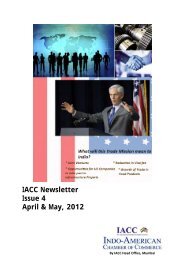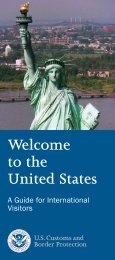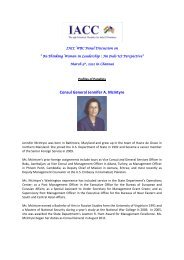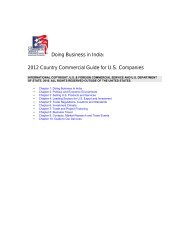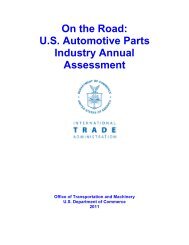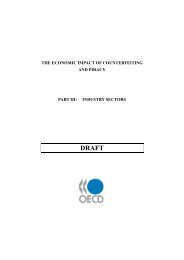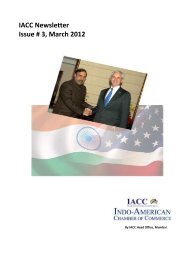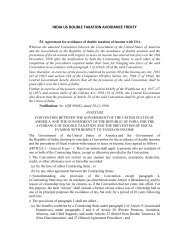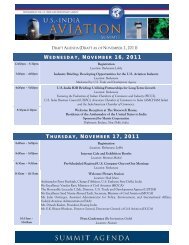Importing into the United States - Indo-American Chamber Of ...
Importing into the United States - Indo-American Chamber Of ...
Importing into the United States - Indo-American Chamber Of ...
Create successful ePaper yourself
Turn your PDF publications into a flip-book with our unique Google optimized e-Paper software.
ENTRY OF GOODS<br />
2. ENTRY PROCESS<br />
When a shipment reaches <strong>the</strong> <strong>United</strong><br />
<strong>States</strong>, <strong>the</strong> importer of record (i.e., <strong>the</strong> owner,<br />
purchaser, or licensed customs broker designated<br />
by <strong>the</strong> owner, purchaser, or consignee)<br />
will file entry documents for <strong>the</strong> goods with<br />
<strong>the</strong> port director at <strong>the</strong> goods’ port of entry.<br />
Imported goods are not legally entered until<br />
after <strong>the</strong> shipment has arrived within <strong>the</strong> port<br />
of entry, delivery of <strong>the</strong> merchandise has been<br />
authorized by Customs, and estimated duties<br />
have been paid. It is <strong>the</strong> importer of record’s<br />
responsibility to arrange for examination and<br />
release of <strong>the</strong> goods.<br />
Pursuant to 19 U.S.C. 1484, <strong>the</strong> importer of<br />
record must use reasonable care in making<br />
entry.<br />
NOTE: In addition to contacting <strong>the</strong> U.S.<br />
Customs Service, importers should contact<br />
o<strong>the</strong>r agencies when questions arise about particular<br />
commodities. For example, questions<br />
about products regulated by <strong>the</strong> Food and<br />
Drug Administration should be forwarded to<br />
<strong>the</strong> nearest FDA district office (check local<br />
phone book under U.S. government listings) or<br />
to <strong>the</strong> Import Division, FDA Headquarters,<br />
301.443.6553. The same is true for alcohol,<br />
tobacco, firearms, wildlife products (furs, skins,<br />
shells), motor vehicles, and o<strong>the</strong>r products and<br />
merchandise regulated by <strong>the</strong> o<strong>the</strong>r federal<br />
agencies for which Customs enforces entry<br />
laws. Appropriate agencies are identified in<br />
Chapter 36.<br />
Addresses and phone numbers for <strong>the</strong>se<br />
agencies are listed in <strong>the</strong> appendix.<br />
Goods may be entered for consumption,<br />
entered for warehouse at <strong>the</strong> port of arrival, or<br />
<strong>the</strong>y may be transported in-bond to ano<strong>the</strong>r<br />
port of entry and entered <strong>the</strong>re under <strong>the</strong> same<br />
conditions as at <strong>the</strong> port of arrival. Arrangements<br />
for transporting <strong>the</strong> merchandise<br />
in-bond to an in-land port may be made by <strong>the</strong><br />
consignee or by a customs broker or by any<br />
o<strong>the</strong>r person with an interest in <strong>the</strong> goods for<br />
that purpose. Unless your merchandise arrives<br />
directly at <strong>the</strong> port where you wish to enter it,<br />
you may be charged additional fees by <strong>the</strong> carrier<br />
for transportation to that port unless o<strong>the</strong>r<br />
arrangements have been made. Under some<br />
circumstances, your goods may be released<br />
through your local Customs port even though<br />
<strong>the</strong>y arrive at ano<strong>the</strong>r port from a foreign<br />
country. Prior to <strong>the</strong> goods’ arrival, arrangements<br />
for entry must be made at <strong>the</strong> Customs<br />
port where you intend to file your duties and<br />
documentation.<br />
Goods to be placed in a foreign trade zone<br />
are not entered at <strong>the</strong> customhouse. See<br />
Chapter 41 for more information on foreign<br />
trade zones.<br />
EVIDENCE OF RIGHT TO MAKE<br />
ENTRY<br />
Goods may only be entered by <strong>the</strong>ir<br />
owner, purchaser, or a licensed customs broker.<br />
When <strong>the</strong> goods are consigned “to order,” <strong>the</strong><br />
bill of lading, properly endorsed by <strong>the</strong> consignor,<br />
may serve as evidence of <strong>the</strong> right to<br />
make entry. An air waybill may be used for<br />
merchandise arriving by air.<br />
In most instances, entry is made by a<br />
person or firm certified by <strong>the</strong> carrier bringing<br />
<strong>the</strong> goods to <strong>the</strong> port of entry. This entity (i.e.,<br />
<strong>the</strong> person or firm certified) is considered <strong>the</strong><br />
“owner” of <strong>the</strong> goods for customs purposes.<br />
The document issued by <strong>the</strong> carrier for<br />
this purpose is known as a “Carrier’s Certificate.”<br />
An example of this certificate is shown in<br />
<strong>the</strong> Appendix. In certain circumstances, entry<br />
may be made by means of a duplicate bill of<br />
lading or a shipping receipt. When <strong>the</strong> goods<br />
are not imported by a common carrier, possession<br />
of <strong>the</strong> goods by <strong>the</strong> importer at <strong>the</strong> time of<br />
arrival shall be deemed sufficient evidence of<br />
<strong>the</strong> right to make entry.<br />
8 U.S. CUSTOMS SERVICE



